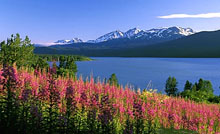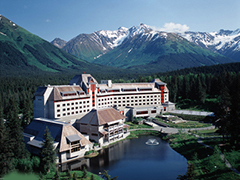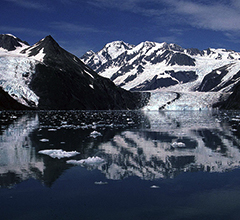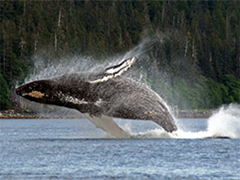|
Originally named Glacier City, Girdwood was founded as a gold mining town. As the number of miners increased, a supply camp arose that also supplied a trail stop on the route between Seward and Ship Creek which is now Anchorage. Girdwood is also known for the award winning Alyeska Resort.Journey by rail into the Grandview Valley and the historic “loop district”, where you’ll be surrounded by alpine meadows, wildlife and wildflowers. Enjoy exceptional views of Trail Glacier, Bartlett Glacier and Spencer Glacier. This tour takes you through some of the most scenic areas of the railbelt. This train makes several stops for passengers traveling to different destinations. Other passengers may (dis)embark the train along the route; but Grandview sightseeing passengers remain onboard. |
Alaska Railroad Vacation and Self Drive Tour Packages

Your Alaska Vacation Planner - Holiday Travel Experts
Welcome to the Land of the Midnight Sun ! We belong to the most trusted Alaskan tour operators and tour experts and we are operating with competence and integrity for many years within the Alaska Tourism Industry. Our licensed and registered tour operator company provides year-around travel services and expert advise for individual customers, tour groups and travel agencies.
Explore Alaska's Top Scenic National Parks - Travel Alaska

Scenic Alaska's Nature beyond Imagination
Visit Alaska's top National Parks such as Glacier Bay, Denali, Wrangell, Lake Clark, Katmai and Kenai Fjords. Our Alaska tour and vacation program features an extensive array of daily sightseeing activities, pre | post destination cruise tour packages from 3-7 days for individuals and groups, active and supported wilderness adventure tours as well as first-class hotels, wilderness lodge or resort accommodation.
Alaska Vacation and Custom Travel Packages

We plan your Alaska Holiday and Vacation Packages
You may customize any Alaska Tour or Alaska Vacation Package from our portfolio to match your travel requirements: Experience world-class salmon fishing, cruise the Inside Passage or Prince William Sound, observe brown bears at Katmai or on Kodiak Island, take a rafting tour on a scenic river, discover the back-country during a guided hiking trip, or observe whales at Glacier Bay - the possibilities are endless.
Alaska Northern Lights Viewing Tours and Iditarod Sled Dog Race

Alaska Winter Adventure, Fairbanks Aurora Viewing Tours and Winter Activities
During the fall and winter months, Alaska is one of the worlds top destinations for some spectacular Aurora Borealis | Northern Lights viewing in Fairbanks, Bettles Lodge or Chena. You may ski at the Alyeska Resort, ride a snowmobile along the Alaska Mountain Range, cross the Arctic Circle or mush your own dog team or observe the world-class Iditarod Sled Dog Race in March.
KEP#05 Alyeska Spa Resort | Prince William Sound Rail Tour
Tour Itinerary
Dates | Rates
Railroad FAQ
Destination Information
|
Day
01 |
 |
Anchorage - Alyeska Resort | Girdwood Depart from Anchorage onboard the Alaska Railroad Glacier Discovery Train to Girdwood and the Alyeska Resort. Arrive at 11:15 am. Transfer to the Alyeska Resort. Experience a luxury interior design with modern touches and rich Native heritage surrounded by unspoiled Alaskan wilderness. The results highlight warm, organic elements to the hotel interiors bringing the natural beauty of the great outdoors inside. Hotel amenities include: luxurious spa and wellness area, saltwater pool, whirlpool, massage, bars, restaurants (Japanese and International Cuisine) and a "own" tram to the top of Mt. Alyeska with it's famous "7-Glacier Restaurant". The 304 guest rooms provide plush carpets, Serta Pillow Top Mattresses, TV, Phone, Radio, luxurious interior décor and complimentary wireless internet access. TIP: try a lunch or dinner the nearby Double Musky Restaurant. Overnight: Alyeska Resort |
|
Day
02 |
 |
Alyeska Resort - Prince William Sound Glacier Cruise - Alyeska Resort Enclosed by mountains and glaciers, and protected from the high seas by barrier islands, Prince William Sound is one of Alaska's premier recreational areas for outdoor adventure activities. Fjords, bays, coves, lakes, glaciers, mountains and hundreds of islands provide scenic settings for day cruises or kayaking tours from Whittier. Our catamaran cruise travels over 140 miles into Prince William Sound where you will see 26 “named” glaciers and many more unnamed. We get very close to towering masses of ice so you can listen to the moves of the glaciers and see the brilliant blues in the ice. Glacier calving are normally seen on each cruise. The types of glaciers you will view are Alpine (hanging), Piedmont and Tidewater Glaciers. During your cruise, you may view sea otters, seals, porpoises and sea lions. The most common whales in Prince William Sound are Humpback and the Orca (Killer) Whale. Guests may also spot bears, bald eagles, mountain goats and over 200 species of birds inhabiting this area. Departure: 12:30 pm, return 5:30 pm including Hot Lunch. Overnight: Alyeska Resort. |
|
Day
03 |
 |
Alyeska Resort - Anchorage Enjoy the entire day at Alyeska Resort and explore the surrounding area. At 7:40 PM board the Alaska Railroad train for a scenic ride along Turnagain Arm to Anchorage. Arrive in Anchorage at 9:15 PM. The tour ends at the railroad station in Anchorage. Tour extensions on request. Please contact us. |
| Rates in US $ / per Person | Single Room | Double Room |
| May + September | $ 1610.00 | $ 1010.00 |
| June, July August | $ 2034.00 | $ 1315.00 |
| Daily Departures |
|
 |
| Alaska Rail Tour Services Regular Seating and Private Dome Car Choices Our Alaska Rail Tours are available with the following classes of service: Denali Star & Coastal Classic Regular Service | Many people prefer the standard class for its single level stability, generous seating and the ability to easily walk between different cars on the train. Gold Star Dome Cars Are the newest first-class rail cars in Alaska with large picture windows and fine dining options. Upper level dome car 360-degree viewing seating, priority check in, outdoor viewing deck. The lower level provides a restaurant, bar and gift shop. Midnight Sun Express Dome Cars | These 2-story dome cars with large multiple outside viewing platforms are operated by a private company. Enjoy the full-time 360-degree view dome seating with plenty of leg – and storage room. Additional features are: GPS assisted monitors, restaurant, bar and gift shop. The 1950’s Vintage Cars | The 1950's-era vintage railcars built by the well known Budd Company were some of the last reminders of the Golden Age of rail. A private company began acquiring Budd dome cars for passenger service on the McKinley Explorer train in Alaska. The seven cars the: Matanuska 508, Chena 509, Chulitna 510, Tanana 512, Talkeetna 513, Kashwitna 553 and Eklutna 554 were purchased and completely refurbished. These railcars were to become the most historic and elegant way to travel through America's Last Frontier. Mc.Kinley Explorer Dome Cars | Are the largest domed cars ever build with plenty of legroom, wide isles and additional luggage storage space. The seats are on the upper level – with restaurant, gift shop and bar downstairs - providing a 360-degree view through the glass windows around and the glass dome above you. All seats are wired so you may listen to music and recorded narration. GPS assisted monitors in each car are tracking the exact location. The covered outside viewing platform is a great feature for a breath of fresh air. All Alaska Rail Tours are including a pre-confirmed and assigned seat as well as on-board narration services. MAP – Modified American Plan (Breakfast & Dinner) is available upon request. |
| Children Rate We provide a reduced tour rate for children up to 11 years. Please refer to each individual tour for more information. Children will be accommodated in parents room. |
| Dining The Midnight Sun Express, the McKinley Explorer and the Alaska Railroad Gold Star Dome Cars are offering full service breakfast, lunch and dinner options (all custom made to order) at the on-board restaurants. You will have the opportunity to visit the dining room and order freshly prepared food from the menu. Since all of our dishes are prepared to order we will do our best to accommodate all dietary concerns. Please notify us of any special dietary requirements at the time of reservation. |
| Gratuities Recommended gratuities to the on-board train staff and host guides are $3.00 to $5.00 per person and day. Gratuities for meal and bar service are entirely discretionary, but 15% is customary in most Alaskan restaurants. All tipping is a matter of your individual preference and is of course - always voluntary. |
| Hotel Accommodation For additional information and addresses on hotels, lodges and resorts included in your railroad tour package, please check our „Info Center“ area. |
| Luggage Transfer & Access Passengers are limited to two pieces of checked baggage, not to exceed 50 pounds, that must be checked with the Alaska Railroad without charge. Each passenger may also take one carry on, not to exceed 2 ” by 14” by 17 ”, which will stored under your seat on the viewing level. Please pack any medications, cameras, binoculars or valuables in your carry-on. |
| Pets Are not allowed onboard (except assistance dogs) |
| Smoking Is not permitted on-board the trains. Smoking is allowed outside on the platforms. Ashtrays are available on the outside viewing platform. |
| Sightseeing Tours Most of our tours are including scheduled sightseeing trips. For more information please refer to each individual tour package. In addition to these scheduled tours we also provide a variety of exciting optional sightseeing trips with a great value. Please Note: Optional sightseeing tours are only available in connection with a confirmed rail tour package reservation. |
| Tickets & Travel Documents You’ll receive your boarding passes, travel documents and additional tour information on the departure day at the rail station. Ticketless travel options are available upon request. |
| Transfers Most scheduled transfers indicated within the itinerary are included in our rail tour packages. Optional pre/post hotel tour accommodation are including transfers from/to the airport. Private limousine and/or group coach transfers are available for an additional charge. |
| Wheelchair Access Each train has at least one rail car that this fully accessible to wheelchairs. A specially designed lift makes getting on and off the train easy and safe. There are also accessible restrooms on each of the accessible rail cars. |
| Alaska Rail Tour Travel Destinations Anchorage to Talkeetna | Anchorage is headquarters to the Alaska Railroad and the journey to Fairbanks begins here. Several miles into the trip, the heavy birch forests of Eagle River and Chugiak lead to the Knik and Matanuska Rivers.The expansive watershed harbors wildlife like moose, bear, the occasional wolf and abundant waterfowl. About 40 miles from Anchorage comes the Matanuska Valley, Alaska's agricultural center and home to the towns of Palmer and Wasilla. Just south of Talkeetna, 70 miles further, the first view emerges of Mt. McKinley, North America's highest peak. The train takes its first stop in Talkeetna, a small town with a mining history and now, a popular takeoff point for climbers to Mt. McKinley. Talkeetna to Denali | From Talkeetna, the track follows the serpentine banks of the Susitna River. On clear days, more views of Mt. McKinley emerge across the river presenting many chances for photos. Black and brown bear frequent the sandbars and scuttle into the brush as the train approaches. Next, the Indian River Canyon is home to many beavers and beaver lodges can be seen in the ponds along the way. The track climbs toward tree line, first crossing Hurricane Gulch, the longest bridge on the railroad just over 914 feet and 296 feet above Hurricane Creek. The train moves into Broad Pass, at 2,363 feet it's the highest point on the railroad, and where caribou migrate through during the fall. Thousands of travelers visit Denali National Park and Preserve to see wildlife like wolves, caribou, Dall sheep, moose and bear, and, of course, Mt. McKinley. Denali to Fairbanks | The coal-mining town of Healy follows after a 10-mile jaunt through Healy canyon, where the surging waters of the Nenana River cuts through the steep-sided cliffs. As the track levels out, Nenana comes into view. It is home to one of the remaining original Alaska Railroad Depots, now a museum and gift shop. The track cuts through the northern boreal forests of interior Alaska. Birch, aspen and willow fill this landscape where gold miners first came to seek their fortunes. Fifty-eight miles from Nenana, Fairbanks, the "Golden Heart City" signals the end of the line - but just the beginning for more adventure, culture and history in the Last Frontier. Seward to Anchorage | Your journey starts in Seward, the southern terminus of the railroad. It quickly begins its climb through primeval forests of Sitka spruce. After crossing Snowy River, Kenai Lake comes into view, set off with its stunning aqua color and surrounded by soaring mountains. Moose Pass - Thirty miles into the trip, the track winds through Moose Pass, a former railroad construction camp on the shores of Trail Lake. As the rail ascends into the Kenai Mountains, it leaves behind the forests and reveals mountain meadows and streams of gin-clear glacial waters. Trail Glacier appears on the right and soon after, the summit of Grandview at 1,063 feet and the historic Loop District - named for a complex series of trestles built to handle the steep grade in the age of steam engines. In the same stretch, Bartlett Glacier crowds the track just 800 feet away. Placer River Valley - After passing through a series of short tunnels, the track descends to the Placer River Valley near Spencer Glacier. Moose, bear and wolves populate the valley among the willow and alder trees. Trumpeter swans migrate through in spring and fall and arctic terns hover above the ponds and river looking for small fish and insects. Twelve miles later Turnagain Arm appears, where 40-foot tides rush into the narrow confines of the Chugach Mountains. Beluga whales pursue salmon and other schooling fish. Next comes Girdwood, home to Alaska's premier ski resort, a 40-mile commute from Anchorage. Chugach National Forest - The Chugach National Forest borders Turnagain Arm, some six million acres, the second largest in the U.S. Bald eagles cruise the thermals above and Dall Sheep come to feed on the low plants growing on the cliffs bordering the track. Next comes Potter Marsh in the Anchorage Coastal Wildlife Refuge. Anchorage is the final stop, 114 miles out of Seward. |
 |
|
| Staff Travel Picks and Destination Roundup Anchorage Anchorage: Is by far Alaska's largest and most sophisticated city, Anchorage is situated in a truly spectacular location. The permanently snow-covered peaks and volcanoes of the Alaska Range lie to the west of the city, part of the craggy Chugach Range is actually within the eastern edge of the municipality, and the Talkeetna and Kenai ranges are visible to the north and south. On clear days Mt. McKinley looms on the northern horizon, and two arms of Cook Inlet embrace the town's western and southern borders. The Native Heritage Center: There are more than 200 Native tribal entities in Alaska. At the Heritage Center, experience the lifestyles and traditions of these Native cultures through art and artifact displays and activities like blanket tossing, parka sewing, and drumming. Portage Glacier: This glacier has been receding rapidly, but you can ride the tour boat Ptarmigan across the lake to view its face. Keep an eye out for office building-size chunks of ice falling into the water. Flattop Mountain: Drive to the Glen Alps parking lot in Chugach State Park and take the short walk west to a scenic overlook on a clear day the view sweeps from Denali south along the Alaska Range past several active volcanoes on the other side of Cook Inlet. Or follow the hikers to the top of the mountain for even more stunning scenery. Native Crafts: Alaska's rich Native culture is reflected in its abundance of craft traditions, from totem poles to intricate baskets and detailed carvings. Many of the native crafts you'll see across the state are results of generations of traditions passed down among tribes; the craft process is usually labor-intensive, using local resources such as rye grasses or fragrant cedar trees. Each of Alaska's native groups is noted for particular skills. Inuit art includes ivory carvings, spirit masks, dance fans, baleen baskets, and jewelry. Also be on the lookout for mukluks (seal- or reindeer-skin boots). The Tlingit peoples of Southeast Alaska are known for their totem poles, as well as for baskets and hats woven from spruce root and cedar bark. Tsimshian Indians also work with spruce root and cedar bark, and Haida Indians are noted basket makers and carvers. Athabascans specialize in birch-bark creations, decorated fur garments, and beadwork. The Aleut, a maritime people dwelling in the southwest reaches of the state, make grass basketry that is considered among the best in the world. |
|
 |
|
| Talkeetna | Denali National Park Denali National Park: is one of the most popular and most visited destinations for a reason: the most accessible of Alaska's national parks and one of only three connected to the state of Alaska highway system. This is a spectacular and scenic 6-million-acre wilderness region offering views of mountains so big they seem like a wall on the horizon, endless wildlife from cinnamon-colored Toklat grizzlies to herds of caribou, to moose with antlers the size of coffee tables and glaciers with forests growing on them. All can be experienced by saddle safari, bus trip, or flightseeing tour. Hike, bike, stroll, or raft through it. Camp out, or bundle up in a cabin. The first 15 mi of the park road are paved, but after that there's just gravel. Visitors must ride on a bus or get off and see Denali on foot. No matter how you get there or which adventure you choose, Denali is truly a wonderful experience. When planning your trip consider whether you want to strike out on your own as a backcountry traveler, or to stay at a lodge nearby and enjoy Denali on day hikes and by shuttle bus. Either option requires some individual advance planning or simply contact us and book one of our package tours with hotel or backcountry lodge overnights, railroad transportation from Anchorage and sightseeing tours. Talkeetna: For the ultimate mountain sightseeing adventure, take a flight from Talkeetna and land on a glacier—if you're early enough in the summer, you can fly onto the Kahiltna Glacier, where teams attempting to summit the mountain gather. Mount McKinley: There are a dozen places between Anchorage and Fairbanks that boast the best viewing of Mt. McKinley. At 20,320 feet, McKinley is the highest peak in North America, and just about any place within 100 mi can be deemed a good viewing area. The crown jewel of Alaska is often shrouded in clouds, but even a glimpse will reveal the sheer size of the snow-covered giantess. |
|
| The Inside Passage | Juneau | Glacier Bay National Park If you don't arrive in Alaska by cruise ship, make a point of taking a ferry trip along the longest, deepest fjord in North America. Depending on which ferry you take, the trip from Juneau to Skagway can be two or six hours long. We recommend taking your time. In the summer the tall peaks surrounding the boats release hundreds of waterfalls from snow and glacial melt. If you're lucky, you'll see pods of orcas, humpbacks, and dolphins. Mt. Roberts, Juneau: The tram takes you up the mountain and, if the weather cooperates, offers great views of the area. It's another cruise-ship favorite, but at least you can have a quick beer as you soak in the scenery. Mendenhall Glacier, Juneau: This drive-up glacier comes complete with visitor center, educational exhibits, nature trails, and, when the cruise ships are in town, lots of bused-in tourists. Don't let the crush of visitors dissuade you from stopping by, though—it's a great resource for learning about glacier dynamics and the natural forces that have shaped Alaska. Glacier Bay National Park | Gustavus: Whether you view this natural wonder by air, boat, or on foot, Glacier Bay is well worth the effort and expense it takes to get there. Gustavus is the gateway to Glacier Bay, the place that the father of the national parks system, John Muir, called "unspeakably pure and sublime" in 1879. It is considered by many to be 70 mi of the finest sea kayaking in the world. The first 24 square mi comprise the Beardslee Islands, a complex system for kayakers who glide atop flat water between tides, enveloped in silence except for the sound of water slapping paddles, the soft spray from a nearby porpoise, and the howl of a wolf in the distance. And you'll likely be enjoying these sights with no other travelers nearby. Still, kayaking in this region presents challenges. There is a lively population of moose and bears on the islands, so it is imperative to choose wisely when setting up camp. Most visitors kayak only to the top of the Beardslees, which can take three to five days round-trip. Alaska Marine Highway System: The ferry provides access twice a week to Gustavus. |
|
| The Kenai Peninsula - Alaska‘s Playground Kenai Fjords National Park: Photogenic Seward is the gateway to the 670,000-acre Kenai Fjords National Park. This is spectacular coastal parkland incised with sheer, dark, slate cliffs rising from the sea, ribboned with white waterfalls, and tufted with deep-green spruce. Kenai Fjords presents a rare opportunity for an up-close view of blue tidewater glaciers as well as some remarkable ocean wildlife. Seward, Exit Glacier: You can take a short, easy walk to view this glacier, or if you're in the mood for a challenge, hike the steep trail onto the enormous Harding Icefield. Scan the nearby cliffs for mountain goats and watch for bears. Seward Sea-Life Center: Spend an afternoon at the Alaska SeaLife Center, with massive cold-water tanks and outdoor viewing decks as well as interactive displays of cold-water fish, seabirds, and marine mammals, including harbor seals and a 2,000-pound sea lion. A research center as well as visitor center, it also rehabilitates injured marine wildlife and provides educational experiences for the general public. Appropriately, the center was partially funded with reparations money from the Exxon Valdez oil spill. Films, hands-on activities, a gift shop, and behind-the-scenes tours ($12 and up) complete the offerings. Homer: at the southern end of the Sterling Highway lies the city of Homer, at the base of a narrow spit that juts 4 mi into beautiful Kachemak Bay. Glaciers and snowcapped mountains form a dramatic backdrop across the water. Protruding into Kachemak Bay, Homer Spit provides a sandy focal point for visitors and locals. A paved path stretches most of the 4 mi and is great for biking or walking. A commercial-fishing-boat harbor at the end of the path has restaurants, hotels, charter-fishing businesses, sea-kayaking outfitters, art galleries, and on-the-beach camping spots. Fly a kite, walk the beaches, drop a line in the Fishing Hole, or just wander through the shops looking for something interesting; this is one of Alaska's favorite summertime destinations.Kachemak Bay: abounds with wildlife, including a large population of puffins and eagles. Tour operators take you past bird rookeries or across the bay to gravel beaches for clam digging. Most fishing charters include an opportunity to view whales, seals, porpoises, and birds close up. At the end of the day, walk along the docks on Homer Spit and watch commercial fishing boats and charter boats unload their catch. Halibut Cove: Directly across from the end of Homer Spit is Halibut Cove, a small artists' community. Spend a relaxing afternoon or evening meandering along the boardwalk and visiting galleries. The cove is lovely, especially during salmon runs, when fish leap and splash in the clear water. Several lodges are on this side of the bay, on pristine coves away from summer crowds. The Danny J ferries people across from Homer Spit, with a stop at the rookery at Gull Island and two or three hours to walk around Halibut Cove. The ferry makes two trips daily: the first leaves Homer at 12:00 pm and returns at 5:00 pm, and the second leaves at 5:00 pm and returns at 10:00 pm.
|
|
| The Winter Wonderland | Aurora Viewing | Skiing | Dog Mushing The most popular attraction in the wintertime doesn't charge admission or have set viewing times. The Northern Lights (Aurora Borealis) seem to appear without rhyme or reason. There is a science to it, but explanations are still hotly debated by meteorologists, astronomers, and pretty-color enthusiasts. Seeing the northern lights requires that there be no nearby city light, very little moonlight, the cold fall and winter months, and a lot of luck. Hot springs outside Fairbanks keep the hopeful warm while they watch the skies. There is something about the incongruous number of hours of sunlight and darkness Alaska gets that makes Alaskans yearn to break the rules of time. When you arrive in Alaska you may feel inclined to do the same. In many parts of the state bars still stay open all night long, fishermen can be sitting on the ice all hours of the night, and some people ski best when the witching hour strikes. At Alyeska Ski Resort in Girdwood, skiers can take the lift and bite the powder under the stars. On weekends this popular ski resort offers night skiing, and afterwards, in the bar, rewards its visitors with live, high-energy, danceable music. This provides a good look at local Alaskan culture, as it caters to tourists and residents alike. |
|
| Alaska's Top Bear Viewing Destinations Katmai National Park | Brooks River: When people come to Alaska they want to see bears. Yet most visitors never get a glimpse, because bears prefer their privacy. But at Katmai National Park, which boasts the largest brown bear population in the world, you're almost guaranteed a photograph of bears doing bear things. Remember, although they look cute, their teeth and claws are still mighty sharp. Kodiak Island: The 1.9-million-acre Kodiak National Wildlife Refuge lies mostly on Kodiak Island and neighboring Afognak and Uganik islands, in the Gulf of Alaska. All are part of the Kodiak Archipelago, separated from Alaska's mainland by the stormy Shelikof Strait. Within the refuge are rugged mountains, tundra meadows and lowlands, thickly forested hills that are enough different shades of green to make a leprechaun cry, plus lakes, marshes, and hundreds of miles of pristine coastland. No place in the refuge is more than 15 mi from the ocean. The weather here is generally wet and cool, and storms born in the North Pacific often bring heavy rains. Dozens of species of birds flock to the refuge each spring and summer, including Aleutian terns, horned puffins, black oystercatchers, ravens, ptarmigan, and chickadees. At least 600 pairs of bald eagles live on the islands, building the world's largest bird nests on shoreline cliffs and in tall trees. Seeing the Kodiak brown bears alone is worth the trip to this rugged country. When they emerge from their dens in spring, the bears chow down on some skunk cabbage to wake their stomachs up, have a few extra salads of sedges and grasses, and then feast on the endless supply of fish when salmon return. About the time they start thinking about hibernating again the berries are ripe (they may eat 2,000 or more berries a day). Kodiak brown bears, the biggest brown bears anywhere, sometimes topping out at more than 1,500 pounds, share the refuge with only a few other land mammals: red foxes, river otters, short-tailed weasels, and tundra voles. Six species of Pacific salmon - chums, kings, pinks, silvers, sockeyes, and steelhead—return to Kodiak's waters from May to October. Other resident species include rainbow trout, Dolly Varden (an anadromous trout waiting for promotion to salmon), and arctic char. The abundance of fish and bears makes the refuge popular with anglers, hunters, and wildlife-watchers. Lake Clark National Park | Redoubt Bay When the weather is good, an idyllic choice beyond the Mat-Su Valley is the 3.4-million-acre Lake Clark National Park and Preserve, on the Alaska Peninsula and a short flight from Anchorage or Kenai and Soldotna. The parklands stretch from the coast to the heights of two grand volcanoes: Mt. Iliamna and Mt. Redoubt (which made headlines in 2009 when it erupted, sending ash floating over the region), both topping out above 10,000 feet. The country in between holds glaciers, waterfalls, and turquoise-tinted lakes. The 50-mi-long Lake Clark, filled by runoff waters from the mountains that surround it, is an important spawning ground for thousands of red (sockeye) salmon. The river-running is superb in this park. You can make your way through dark forests of spruce and balsam poplars or hike over the high, easy-to-travel tundra. The animal life is profuse: look for bears, moose, Dall sheep, wolves, wolverines, foxes, beavers, and mink on land; seals, sea otters, and white (or beluga) whales offshore. Wildflowers embroider the meadows and tundra in spring, and wild roses bloom in the shadows of the forests. Plan your trip to Lake Clark for the end of June or early July, when the insects may be less plentiful. Or consider late August or early September, when the tundra glows with fall colors. |
|
| Wrangell St. Elias National Park In a land of many grand and spectacularly beautiful mountains, those in the 9.2-million-acre Wrangell-St. Elias National Park and Preserve are possibly the finest of them all. This extraordinarily compact cluster of immense peaks belongs to four different mountain ranges. Rising through many ecozones, the Wrangell-St. Elias Park and Preserve is largely undeveloped wilderness parkland on a grand scale. The area is perfect mountain-biking and primitive-hiking terrain, and the rivers invite rafting for those with expedition experience. The mountains attract climbers from around the world; most of them fly in from Glennallen or Yakutat. The nearby abandoned Kennicott Mine is one of the park's main visitor attractions. The open pit mine is reminiscent of ancient Greek amphitheatres, and the abandoned structures are as impressive as the mountains they stand against. |
|
| Prince William Sound Tucked into the east side of the Kenai Peninsula, the sound is a peaceful escape from the throngs of people congesting the towns and highways. Enhanced with steep fjords, green enshrouded waterfalls, and calving tidewater glaciers, Prince William Sound is a stunning arena. It has a convoluted coastline, in that it is riddled with islands, which makes it hard to discern just how vast the area is. The sound covers almost 15,000 square mi—more than 12 times the size of Rhode Island—and is home to more than 150 glaciers. The sound is vibrantly alive with all manner of marine life, including salmon, halibut, humpback and orca whales, sea otters, sea lions, and porpoises. Bald eagles are easily seen soaring above, and often brown and black bears, Sitka black-tailed deer, and gray wolves can be spotted on the shore. Unfortunately, the Exxon Valdez oil spill in 1989 heavily damaged parts of the sound, and oil still washes up on shore after high tides and storms. The original spill had a devastating effect on both animal and human lives. What lasting effect this lurking oil will have on the area is still being studied and remains a topic of much debate. Bring your rain gear, Prince William Sound receives more than 150 inches of rain per year. The sound is best explored by charter boat or guided excursion out of Whittier, Cordova, or Valdez. Even though the waters are mostly protected, open stretches are common, and the fickle Alaska weather can fool even experienced boaters. From the road system, Whittier and Valdez are your best bets for finding charter outfits.
|
|
Go Alaska Tours | Secured Reservation Request Form

A secure transmission of your personal information is very important for the Alaska Travel Network Group LLC at these days and that's why we have taken steps to ensure that we have the most secure method of transmission on the Internet available. All online reservation request and contact forms are providing a SSL (Secure Sockets Layer) technology with a 128-bit encryption for transmission of data between your web browser and our web server which provides the highest level of protection from tampering and eavesdropping. 128-bit encryption is considered so secure that cryptographers consider it impossible to crack. There is no safer way for your personal information to be transmitted. In fact, both the Canadian and US Governments use 128-bit encryption for transmission of their sensitive data. The Go Alaska Tours Website (www.goalaskatours.com) uses GeoTrust for its SSL and 128-bit encryption.
